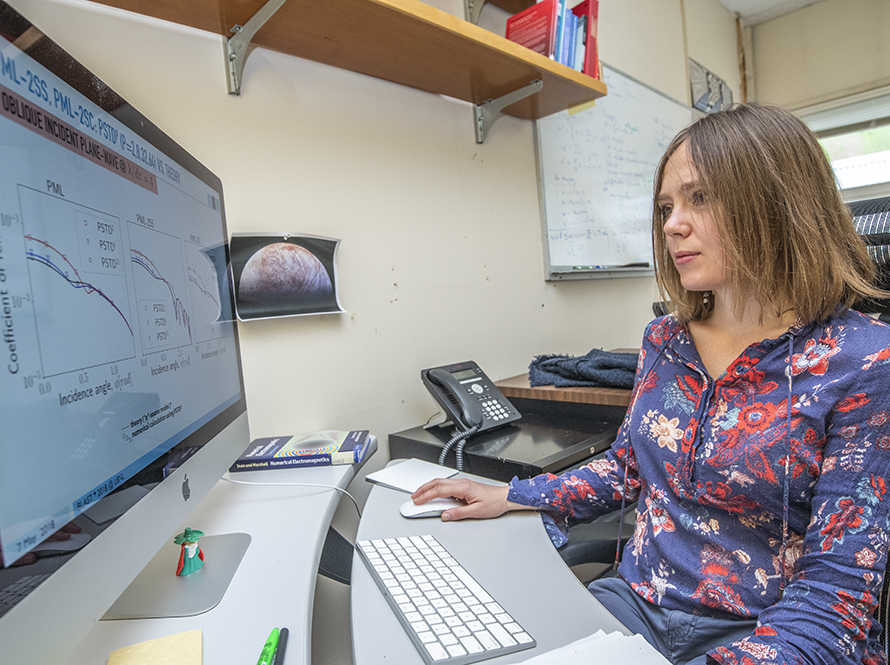Scientific Achievement
Researchers from the Advanced Modeling Program (AMP) in the Accelerator Technology & Applied Physics Division at Lawrence Berkeley National Laboratory (Berkeley Lab) have developed a novel formulation of the Particle-In-Cell (PIC) method for modeling relativistic plasmas. The development of plasma-based accelerators, fusion, and many other areas of plasma and beam science relies heavily on PIC simulations, and the new method extends their applicability to a broader range of parameters that would otherwise be challenging to explore or validate when designing such accelerators.
Significance and Impact

Normalized NCI growth rates of a uniform plasma drifting at relativistic velocity. NCI growth rates were calculated from (a) theory and (b) WarpX simulations using a standard spectral solver (bottom-left) and the novel solver (bottom-right). No instability growth was found with the novel solver using the same time dependencies of J and rho.
PIC simulations of relativistic flowing plasma are crucial for several fields, including laser-wakefield acceleration. However, the well-known numerical Cherenkov instability (NCI) often hinders simulations of relativistic plasma. This work presents a novel generalization of the PIC algorithm, relaxing traditional built-in linear and constant time dependencies of the charge and current densities with the arbitrary time dependencies within one PIC cycle. The researchers found that the new method is remarkably NCI-stable when paired with a specific form of Maxwell’s equations integrated over time using the pseudo-spectral analytical time-domain (PSATD) method.
Research Details
Derivation of the novel PIC-JRhom algorithm

Longitudinal electric field (Ez) from 3D WarpX simulations of two consecutive laser-driven plasma accelerator stages. The laser (not shown) that drives the wake propagates from left to right. Shown are (a) small timestep (reference) and (b) large time step simulations. The novel algorithm eliminates the Cherenkov instability, produces accurate physics results, and provides a 2.2x speedup compared to the Galilean reference case, while the standard “averaged Galilean algorithm” is NCI stable. However, it leads to a significantly diminished electric field amplitude in the second stage.
Simulations of relativistic plasmas often rely on the electromagnetic PIC method, with variations of the method chosen based on the application. For the modeling of plasma-based accelerators, a variation that has gained in popularity uses the “infinite-order” (in space and time) PSATD method. This method replaces the widely used second-order (in space and time) Finite-Difference Time-Domain (FDTD) Yee method to solve Maxwell’s equations at discrete points in space and time. In contrast to the Yee solver, the PSATD solver offers little or no numerical dispersion and no time step condition on the field solve.
However, when coupled with the Lorentz boosted frame method to speed up simulations, only a few variations of PSATD solvers are NCI stable, with constraints on the numerical parameters that can be chosen.
The novel formulation of the PSATD PIC relaxes the standard assumption that the current density produced by the particles is constant over a timestep, enabling larger timesteps and, hence, shorter runtimes. This is accomplished by enabling the handling of arbitrary time dependencies of the charge and current densities during one timestep.
The new algorithm expands the range of numerical parameters under which PIC simulations are stable and accurate when modeling relativistic plasmas, such as those found in plasma-based particle accelerators.
Extensions of the PIC-JRhom algorithm
The novel PIC-JRhom algorithm has been implemented in WarpX, an open-source electromagnetic PIC code. The current implementation provides the flexibility to choose an arbitrary polynomial-time dependency of the current and charge densities and the number of subintervals within one timestep.
Numerical stability
Numerical tests and theoretical analysis of a uniform plasma drifting at relativistic velocity show that having the same time dependency for the evolution of the charge and current densities over one time step leads to excellent NCI stability.
Application to plasma acceleration
The new algorithm was effective, efficient, and versatile for controlling the numerical Cherenkov instability in plasma accelerator simulations. This holds for cases for which other methods—e.g., Galilean or averaged Galilean PIC—are applicable, but more importantly, for cases that are more challenging for other approaches. This allows simulations of larger systems for modeling future accelerators and colliders.
Contact: Olga Shapoval and Jean-Luc Vay
Researchers: Olga Shapoval, Edoardo Zoni, Remi Lehe, and Jean-Luc Vay (Berkeley Lab); and Maxence Thevenet (DESY, Germany)
Funding: This research was supported by the Exascale Computing Project (17-SC-20-SC), a collaborative effort of the U.S. Department of Energy Office of Science and the National Nuclear Security Administration. It is also based on work supported by the CAMPA collaboration, a project of the U.S. Department of Energy, Office of Science, Office of Advanced Scientific Computing Research, and Office of High Energy Physics, Scientific Discovery through Advanced Computing (SciDAC) program.
Publication: Shapoval O., Zoni E., Lehe R., Thevenet M., and Vay J.-L. “Pseudospectral particle-in-cell formulation with arbitrary charge and current-density time dependencies for the modeling of relativistic plasmas,” Phys. Rev. E, (2024) 110(2-2): 025206. https://doi.org/10.1103/PhysRevE.110.025206
For more information on ATAP News articles, contact caw@lbl.gov.
